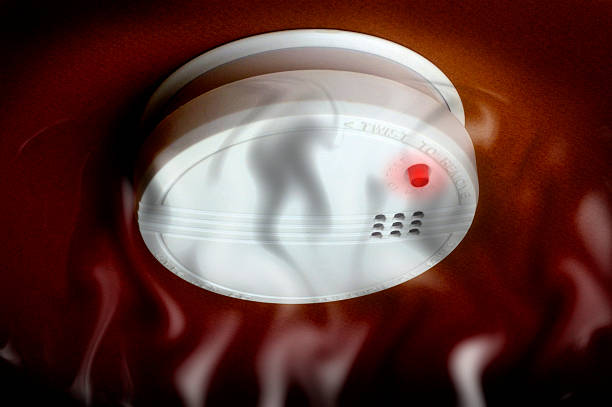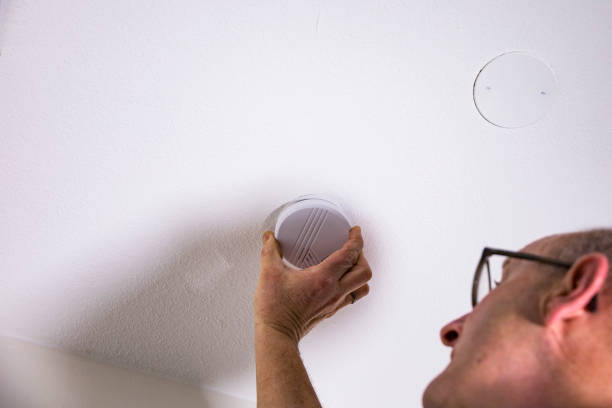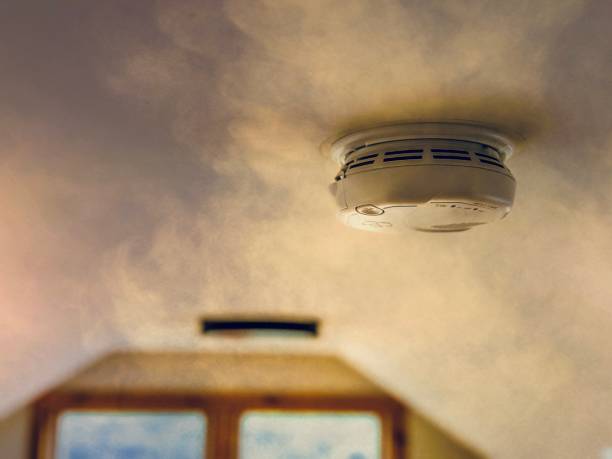That relentless, high-pitched chirp… If you’re reading this, the maddening sound of a Kidde smoke detector beeping is likely disrupting your peace. Whether it’s robbing you of sleep or causing daytime frustration, we understand. That incessant chirp, often starting at the worst possible moment, is a common headache for homeowners.
But here’s the critical thing to remember: that Kidde smoke detector beeping is not just random noise. It’s a specific signal, a cry for attention from a device designed to protect you. While it’s typically not the loud, continuous alarm indicating immediate danger (like a fire), ignoring the chirp is risky. It means something needs maintenance or replacement to ensure your detector works when you need it most.
Kidde, a leader in fire safety, engineers its detectors with distinct alerts. This comprehensive guide, updated for 2024, will demystify that Kidde smoke detector beeping. We’ll walk you through every likely cause, drawing from official Kidde documentation, expert discussions, and real-world user experiences shared online. From the simple fix of a low battery to recognizing the vital end-of-life signal, you’ll learn how to diagnose the issue and implement the solution safely and effectively. Let’s silence that persistent beep for good!
In a Hurry? Quick Fix Summary
Need to stop the Kidde smoke detector beeping right now? Try these common solutions first:
- Low Battery: Single chirp every 30-60 seconds? Fix: Replace the battery with the exact recommended type (check inside!). Crucially, perform the Full Reset Procedure (hold test button 15-30s with NO power connected) before reinstalling.
- Expired Unit: Is the detector about 10 years old? Check the manufacture date on the back label. Fix: This requires complete replacement of the unit. New batteries or cleaning won’t fix expired sensors.
- Dirty Sensor: Experiencing random, intermittent chirps? Fix: Carefully vacuum around all vents/openings. Use compressed air (optional) following instructions. Perform the Full Reset Procedure.
- Reset Needed (Especially Hardwired): Chirping continues after battery change or power flicker? Fix: Perform the complete Full Reset Procedure described below (disconnect all power, hold test button, reconnect).
For detailed explanations and other potential causes, please read the relevant sections.
Critical Distinction: Chirp vs. Full Alarm

Before troubleshooting, identify the sound precisely:
- The Chirp / Beep (Maintenance Signal):
- Sound: A single, high-pitched “beep” or “chirp”.
- Frequency: Occurs intermittently, typically every 30 to 60 seconds (Source^1, ^2).
- Meaning: This is the Kidde smoke detector beeping we’re focused on. It signals a need for maintenance (like a low battery, dirt, or end-of-life) or a unit fault. It requires attention but is NOT an immediate emergency alert.
- The Full Alarm (EMERGENCY SIGNAL):
- Sound: A LOUD, often continuous or repeating series of three beeps (the standard T3 pattern: BEEP-BEEP-BEEP – pause – BEEP-BEEP-BEEP).
- Frequency: Continuous or near-continuous during the alert condition.
- Meaning: DANGER! Indicates the potential presence of smoke or dangerous carbon monoxide levels (for combo units).
- ACTION: EVACUATE IMMEDIATELY. Get everyone out of the house. Call 911 or your local emergency services from a safe location outside. Some Kidde models announce the danger type (“Fire!” or “Warning: Carbon Monoxide!”) (Source^12).
Never dismiss a full alarm. This guide exclusively addresses the intermittent maintenance chirp/beep.
Cause #1: The Low Battery Warning (Most Common Culprit)
More often than not, that annoying Kidde smoke detector beeping is simply telling you its battery is running low. Detectors perform self-checks, and when power dips, the chirping starts.
What to Expect:
- Consistent Chirp: A single beep every 30 to 60 seconds.
- Warning Period: Designed to chirp for at least 7 days before the battery dies completely, giving you time to replace it (Source^1). Don’t delay – a failing battery compromises protection.
- Hardwired Units Too: Units wired to AC power still use a backup battery. If the main power is out, or if that backup battery gets weak, the hardwired Kidde smoke detector beeping will commence (Source^2).
That Infuriating Nighttime Chirp Explained
Why does it always seem to start at 3 AM? It’s linked to the low battery issue and temperature changes:
- Nighttime Temperature Drop: Homes are usually coolest between 2-6 AM (Source^6). Temperatures can dip into the 40-50°F (4-10°C) range.
- Battery Chemistry: Colder temperatures temporarily reduce a battery’s voltage output (Source^19, ^27).
- Triggering the Threshold: If the battery is already weak, this slight voltage drop is often enough to trigger the low-battery chirp. The beeping might stop as the house warms up, creating a frustrating cycle. Consistent nighttime chirping = Probable low battery.
Step-by-Step: Fixing the Low Battery Beep
- Identify Correct Battery: Carefully remove the detector cover or twist it off the base. Check the compartment or label for the required battery type (e.g., 9V Alkaline, AA Alkaline). Using the exact type and brand recommended by Kidde is crucial (often Duracell or Energizer Alkaline are specified) (Source^10). Using incorrect types (lithium unless specified, rechargeable) can lead to malfunction.
- Remove Old Battery: Dispose of the old battery properly.
- Perform Discharge/Reset (DO NOT SKIP): With the old battery OUT and the unit UNPLUGGED (if hardwired), press and HOLD the test button for 15-30 seconds. This drains residual charge that causes phantom beeping (Source^2, ^11).
- Insert Fresh Battery: Install the new, correct battery, ensuring proper polarity (+/-) alignment.
- Close & Test: Secure the battery door/cover. Reattach the detector. Press and hold the test button. The alarm should sound loudly for a moment, then stop. This verifies correct operation.
Proper battery replacement, including the reset, is the most common fix for Kidde smoke detector beeping. Consider changing batteries annually or biannually. More tips here: Smoke Detector Battery Guide.
Cause #2: Detector Has Expired (End-of-Life Signal)
Like any electronic device, smoke detectors wear out. Their sensors degrade over time, becoming less reliable. Kidde units have a built-in End-of-Life (EOL) warning chirp.
Why Smoke Detectors Don’t Last Forever
- Standard Lifespan: 10 years from the date of manufacture (DOM) printed on the device – not from when you installed it (Source^8, ^15). This is an industry standard.
- CO Sensor Lifespan: In combination Smoke/CO alarms, the CO sensor might expire sooner, often after 7 or 10 years (check your model) (Source^7, ^24). The earlier EOL date determines replacement time for the whole unit.
- The EOL Signal: This is different from the low-battery chirp. Check your manual, but common EOL signals include:
- A chirp every 30 seconds (can overlap with low battery sound – checking the date is essential!)
- Multiple chirps in quick succession (e.g., 5 chirps per minute).
- Chirps combined with specific LED flashes (e.g., red LED flash + chirp).
- Critical for Safety: Relying on an expired detector is dangerous. It may fail to alert you in a real emergency.
Step-by-Step: Replacing an Expired Unit
- Find the Date Label: Remove the detector. Look on the back/side label for the Date of Manufacture (DOM) and/or a “Replace By” date.
- Calculate Expiry: If only DOM is shown, add 10 years (or the specific lifespan noted on the unit/manual). If “Replace By” is printed, adhere to that date. For combo units, use the earliest EOL date (smoke or CO sensor).
- Replace Immediately: If the Kidde smoke detector beeping matches the EOL signal and the date confirms expiry, the only solution is complete replacement (Source^7, ^8, ^10). New batteries or cleaning will not fix expired sensors.
Purchase a new UL-listed detector. Check local regulations for proper disposal of the old unit. The NFPA website offers guidance on selecting and placing new alarms.
Cause #3: Dirty Sensing Chamber (Dust, Bugs, Grime)
Inside your detector is a chamber where air is sampled. Contaminants can interfere with its operation.
How Debris Causes Faulty Beeping
- Obstruction & Interference: Dust, cobwebs, pet hair, cooking grease particles, and even small insects like spiders can accumulate inside the sensing chamber (Source^3, ^8). User reports frequently mention spiders causing issues (Source^3).
- Sensor Malfunction: This buildup can either block the sensor (delaying real alarm activation) or trick it into thinking smoke is present, causing random, intermittent Kidde smoke detector beeping or frustrating false alarms (Source^3). Kidde recommends regular cleaning as a preventative measure (Source^8, ^10).
Step-by-Step: Cleaning Your Kidde Detector Safely
Perform this maintenance every 6 months, or more often if needed.
- Power Down (Hardwired Units): For safety, turn off the circuit breaker powering the smoke alarm circuit.
- Remove Detector: Take the unit down from its mounting base.
- Vacuum Thoroughly: Use a vacuum cleaner with a soft brush attachment. Carefully vacuum all around the outside vents, seams, and openings of the detector casing (Source^8, ^10).
- Use Compressed Air (Recommended): Hold a can of compressed air upright. Use short bursts to blow air through the vents from a distance of a few inches. This helps dislodge internal dust from the sensing chamber. Never spray directly into openings at close range.
- Wipe Exterior: Use a clean, dry microfiber cloth (or one very lightly dampened with water only) to wipe the outer casing. ABSOLUTELY NO cleaning solutions or excessive water.
- Reinstall & Reset: Reattach the detector. Restore power (if turned off). Crucially, perform the Full Reset Procedure now if you haven’t already.
- Test: Press and hold the test button to ensure it’s working correctly.
Regular cleaning often cures unexplained Kidde smoke detector beeping. Link it to your battery change schedule! See more at Smoke Detector Maintenance Tips.
Cause #4: Hardwired Unit Power Issues (Reset Needed!)

Detectors wired into your home’s electrical system can have unique beeping triggers related to power.
AC Power Loss or Interruption
- Issue: A tripped breaker, loose wiring connection, or general power outage forces the unit onto its backup battery. If that battery is weak, it chirps ([See Cause #1]). Sometimes, unstable AC power itself might cause chirps (Source^1).
- Fix: Always check your circuit breaker panel first. Find the breaker for the smoke alarms and ensure it’s fully ON. Reset if necessary.
The Annoying Residual Charge Problem
- Issue: A very common source of frustration! Even after removing the battery and disconnecting AC power, capacitors inside the unit can hold a residual charge, causing the Kidde smoke detector beeping to continue for a while (Source^2, ^9). This leads users to think the sound is coming from the empty junction box (Source^5).
- Fix: The Full Reset Procedure detailed below is specifically designed to drain this charge.
Trouble with Interconnected Alarms
- Issue: Most hardwired alarms are interconnected (if one sounds, they all sound). A fault or malfunction in one single unit (bad sensor, failing component, wiring fault) can sometimes trigger intermittent chirping or false alarms on that unit or even others in the network. This is often discussed in electrical forums (Source^39, ^41).
- Fix: Perform the reset on ALL units first. If problems persist, identifying the faulty unit might require disconnecting them one by one (using the reset steps each time). If you suspect wiring issues within the walls/junction boxes, professional help is needed.
Step-by-Step: The Essential Hardwired Reset
This critical procedure resolves many persistent Kidde smoke detector beeping mysteries, especially after battery changes, power outages, or false alarms:
- CUT AC POWER: Go to your home’s circuit breaker panel. Switch OFF the breaker that controls the smoke detector circuit. Verify power is off (e.g., the detector’s green AC power light should be off).
- DISCONNECT UNIT: Carefully remove the chirping detector from its mounting bracket. Unplug the wiring harness connecting it to the house wiring (usually a small plastic connector).
- REMOVE BATTERY: Open the battery compartment and take out the backup battery.
- DISCHARGE RESIDUAL POWER (KEY STEP): With the unit completely de-energized (no AC, no battery), PRESS AND HOLD the TEST BUTTON continuously for 15-30 seconds. You might hear a faint final chirp as the capacitors discharge – this is normal (Source^2, ^11).
- INSTALL FRESH BATTERY: Insert a new, correct-type battery, checking polarity.
- RECONNECT WIRING: Securely plug the wiring harness back into the detector.
- REMOUNT DETECTOR: Attach the unit back onto its bracket.
- RESTORE AC POWER: Go back to the breaker panel and switch the circuit breaker back ON.
- TEST: The detector may beep briefly upon power-up. Wait 1-2 minutes for it to stabilize. Then, press and hold the test button to confirm it functions correctly. Repeat this entire process for other units if the problem affects an interconnected system.
Mastering this full reset is key to solving many stubborn Kidde smoke detector beeping situations.
Cause #5: Environmental Factors (Location, Humidity, Temp)
Where your detector is located and the surrounding conditions can sometimes cause unwanted chirps or alarms.
Common Environmental Triggers
- High Humidity / Steam: Areas near bathrooms (especially without good ventilation) or kitchens can experience high humidity or steam, potentially triggering chirps or false alarms (Source^1). Kidde manuals acknowledge cooking fumes can cause nuisance alarms (Source^12).
- Temperature Extremes & Drafts: Installation outside the recommended range (typically 40°F-100°F / 4°C-38°C) (Source^1, ^8) – like cold attics, hot garages, near fireplaces – can cause malfunction, including triggering low-battery warnings in the cold ([See Nighttime Chirp section]). Strong drafts from vents blowing directly on the unit can also cause issues by rapidly changing temperature or blowing dust into the sensor.
- Sensor Type Matters: Ionization sensors are generally more prone to nuisance alarms from cooking particles than photoelectric sensors (Source^16). Consider this if placement near a kitchen is unavoidable.
Step-by-Step: Addressing Environmental Issues
- Evaluate Location: Is the detector installed according to NFPA guidelines (on every level, inside/outside sleeping areas, but not too close to kitchens/baths/vents)? The NFPA generally advises at least 10 feet from cooking appliances.
- Improve Airflow: Use exhaust fans diligently during and after cooking and showering to reduce steam and humidity near detectors.
- Relocate if Problematic: If a specific location consistently causes environmental triggers despite ventilation, move the detector to a more suitable nearby spot, adhering to placement rules.
- Consider Detector Technology: For areas prone to cooking fumes, a detector with a photoelectric sensor or a feature like Kidde’s “Smart Hush” might perform better.
Adjusting placement or managing the environment can often stop situation-specific Kidde smoke detector beeping.
Cause #6: Mistaken Identity (Is It Even This Detector?)
It sounds simple, but are you sure the beeping is coming from the Kidde smoke detector you’re focused on?
Other Devices That Chirp
- Carbon Monoxide (CO) Alarms: Separate CO alarms (plug-in, battery) have their own low-battery and EOL chirps, often sounding very similar (Source^24). Your Kidde might be a combo unit chirping about its CO sensor. User forums contain stories of people chasing phantom chirps only to find a hidden CO alarm was the source (Source^5).
- Security System Components: Window/door sensors, motion detectors sometimes beep when their battery is low.
- Other Household Gadgets: Water leak sensors, radon detectors, some smart devices, even UPS battery backups can emit chirps.
- Hidden/Forgotten Detectors: Check unusual spots – closets, attics, basements, behind furniture. An old, disconnected detector with a dying battery could be the culprit (Source^5).
Step-by-Step: Finding the Real Beeping Source
- Isolate the Sound: Stand directly under each smoke alarm and CO alarm for at least a minute. Move around the room/hallway. Close doors to help pinpoint the location.
- Check Every Alarm: Don’t just focus on one. Systematically check the status (lights, test button, date) of all smoke and CO alarms in your home.
- Identify Combo Units: Know which of your detectors monitor both smoke and CO (Source^12, ^24). Their signals can be different.
- Play Detective: If the source is still elusive, conduct a thorough search of potential hiding spots.
Confirming the actual source of the Kidde smoke detector beeping saves time and frustration.
Crucial Safety: What NOT To Do

When faced with a persistent Kidde smoke detector beeping, avoid these common but dangerous mistakes:
- NEVER Ignore It: That chirp demands attention for a safety reason.
- NEVER Remove the Battery (Permanently): Only take the battery out if you are immediately replacing it or the entire unit. A detector without power is useless.
- NEVER Use Incorrect Batteries: Stick to Kidde’s recommendations (type and chemistry). Using the wrong battery invites malfunction (Source^10).
- NEVER Paint Over Detectors: Paint clogs sensors and vents, disabling the alarm.
- NEVER Use Water or Cleaners: These damage sensitive electronics. Clean only as directed (vacuum, careful compressed air, dry cloth).
- NEVER Permanently Disconnect Hardwired Units: Leaving a gap in your interconnected system compromises safety. Fix the issue or replace the unit.
Prioritize safety over temporary silence.
Still Beeping? Advanced Troubleshooting Steps
You’ve tried all the standard fixes, but the Kidde smoke detector beeping mockingly continues. Here are a few more things to consider:
- Retry the Full Reset: Sometimes, the discharge step needs to be extra thorough. Repeat the Hardwired Reset Procedure meticulously.
Checking Model-Specific Issues Online
- Search Your Model Number: Check online forums like Reddit (r/firealarms, r/homeimprovement) or specialized sites (The Fire Panel Forums, Mike Holt Forums) for your specific Kidde model number (e.g., “Kidde PI2010 random chirping”). Users often share solutions or report known quirks for particular models (Source^7, ^33).
- Sealed (“Worry-Free”) Units: If your Kidde has a sealed 10-year battery, chirping usually means EOL or a unit fault requiring replacement. Troubleshooting options are limited; consult its specific manual.
Considering Reliability and Alternatives
- Persistent Problems & User Reports: Some users do report ongoing issues with certain models, leading them to switch brands after exhausting troubleshooting efforts (Source^3, ^7). If a unit is consistently problematic and not brand new, replacement might be the most practical path.
- Choosing a Replacement: If replacing, research current options from Kidde and other trusted brands (like First Alert/BRK). Consider sensor types (photoelectric recommended near kitchens, dual for broader coverage), interconnectivity, and potential smart features.
When to Call for Professional Help
- Contact Kidde: If the detector is relatively new or you suspect a defect, contact Kidde Customer Support. They might offer warranty support or further troubleshooting.
- Call an Electrician: If you have hardwired units and suspect faulty house wiring, loose connections in junction boxes, or issues with the interconnect signal, do not attempt complex electrical work yourself. Call a qualified, licensed electrician for diagnosis and repair (Relevant discussions on forums like Source^41 highlight the complexities).
Final Thoughts: Silence the Chirp, Ensure Protection
A Kidde smoke detector beeping is a solvable problem. By methodically addressing the likely causes – low batteries, unit expiry, dirt/debris, power issues requiring a reset, or environmental factors – you can restore quiet and, more importantly, ensure your home’s fire protection is intact.
Your Action Plan:
- Identify the Sound: Is it a chirp or a full alarm?
- Start Simple: Check batteries (use the right type!) and perform the Full Reset.
- Check the Date: Replace units over 10 years old immediately.
- Clean Regularly: Prevent dust buildup.
- Test Monthly: Press the test button on ALL detectors every month.
Don’t let that chirp become background noise. Address it promptly. Your safety could depend on it.
Found this guide helpful? Bookmark it for future reference! Share it with friends or family dealing with a similar issue. For more smoke detector help, visit us at Smoke Detector Beeping Solutions.
References
(Includes all sources provided in the initial prompt, assuming they are valid and support the points cited)


发表回复